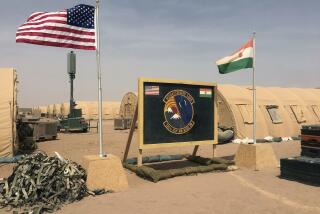Bulk of Invasion Troops Will Leave Panama
- Share via
WASHINGTON — The Pentagon is moving to withdraw the bulk of the 14,000-member invasion force from Panama, leaving behind several thousand troops beyond normal levels to maintain order and help rebuild a nation shattered by U.S. economic sanctions and the invasion, officials said Thursday.
Defense Secretary Dick Cheney said the surrender of former dictator Manuel A. Noriega to U.S. law enforcement authorities will make it easier for President Guillermo Endara to create a government and thus hasten the American military withdrawal.
The Pentagon chief called the arrest of Noriega “the icing on the cake. It’s the completion of the operation.”
“We now have to help in the rebuilding process in Panama. I don’t think we want to walk away from what we’ve begun there,” Cheney said in an interview on Cable News Network. “But the process, from a military standpoint, is nearing completion, and we should soon be able to begin the process of bringing home more of our troops.”
Cheney said he hopes to have the bulk of the invasion force back in the United States “in a few weeks.” He said 2,000 soldiers have returned since Dec. 28. That leaves about 25,400 U.S. troops in place Thursday, including the 13,000 stationed there before the invasion.
Those regular troops will be buttressed by several thousand military police and so-called “civil affairs” troops now arriving from the United States, who specialize in reconstruction, relief and advising nascent governments.
Gen. Colin L. Powell, chairman of the Joint Chiefs of Staff, traveled to Panama on Thursday to meet with U.S. commanders and draw up a timetable for bringing combat troops home. Cheney said he expects to announce a detailed schedule of withdrawals in the next several days.
Administration officials and outside analysts agreed Thursday that it is important to reduce the large and highly visible American military presence in Panama to avoid the appearance that the United States is digging in for an extended occupation.
U.S. forces have little experience in occupation duty, and their presence in huge numbers in Panama creates serious political and public relations problems throughout Latin America.
U.S. Aid Needed
Panamanian Archbishop Marcos G. McGrath said in a broadcast interview Thursday that while Panama needs American reconstruction assistance, the United States should “get out as soon as possible and get out without foreshortening any of the national rights of Panama, as a sign that this was really a mission to that purpose and not a mission that would take advantage of (America’s) physical power.”
“There are three things the U.S. must do now,” said Sol M. Linowitz, the American diplomat who served as ambassador to the Organization of American States and who negotiated the 1979 treaty that will turn over the Panama Canal to the Panamanians at the end of the century.
“One is to get the troops out of there as soon as possible, as soon as the Panamanians have shown they are able to establish and maintain order. Second, to make clear that we are prepared to offer generous help to the Panamanians in dealing with their economic problems, particularly the shambles that resulted from our actions, particularly the sanctions and later the invasion.
“And third, perhaps not as obvious, but of foremost importance, is to make clear . . . that in Panama we had special circumstances that led to our unilateral action and we are prepared to work closely with countries of Latin America to rebuild inter-American cooperation,” Linowitz said.
The credibility of the Endara government is at stake, Cheney acknowledged. The United States cannot run Panama indefinitely without undermining Endara and creating a new political crisis, Administration officials have said.
“I don’t see the role of the United States in Panama on any kind of permanent basis involving the police function,” the defense secretary said.
“The Panamanian government, under President Endara, has made good progress in terms of reestablishing the security forces, the Panamanian Public Force (successor to the Panama Defense Forces).”
More to Read
Sign up for Essential California
The most important California stories and recommendations in your inbox every morning.
You may occasionally receive promotional content from the Los Angeles Times.













